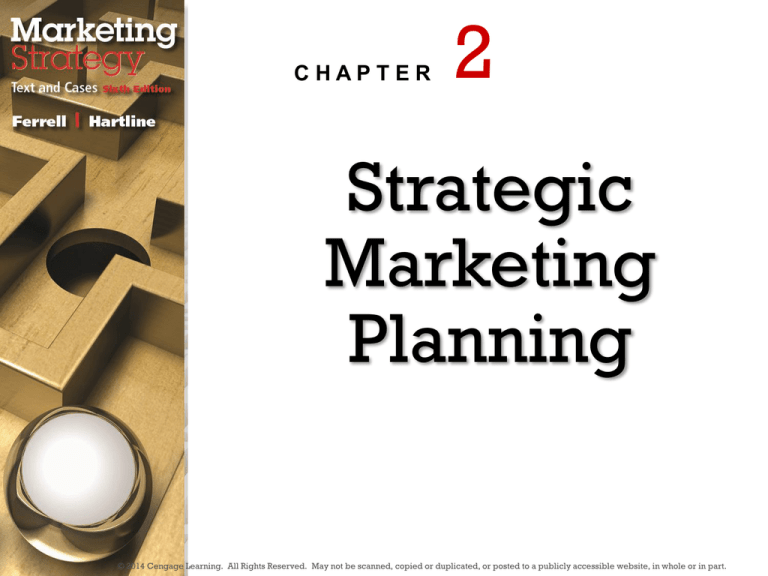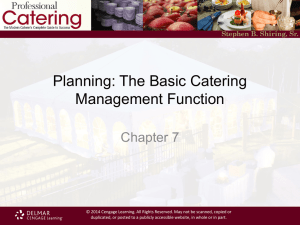
CHAPTER
2
Strategic
Marketing
Planning
© 2014 Cengage Learning. All Rights Reserved. May not be scanned, copied or duplicated, or posted to a publicly accessible website, in whole or in part.
The Strategic Planning Process
Situation
Analysis
An in-depth analysis of the organization’s internal and external
environments
Marketing
Plan
A written document that provides the blueprint or outline of
the organization’s marketing activities, including the
implementation, evaluation, and control of those activities
Explains how the organization will achieve its goals and
objectives
Serves as a “road map” for implementing the marketing strategy
Instructs employees as to their roles and functions
Provides specifics regarding the allocation of resources, specific
marketing tasks, responsibilities of individuals, and the timing of
marketing activities
2
© 2014 Cengage Learning. All Rights Reserved. May not be scanned, copied or duplicated, or posted to a publicly accessible website, in whole or in part.
The Strategic Planning Process
(Exhibit 2.1)
3
© 2014 Cengage Learning. All Rights Reserved. May not be scanned, copied or duplicated, or posted to a publicly accessible website, in whole or in part.
Organizational Mission versus
Organizational Vision
Mission
Answers… “What business are we in?”
Clear and concise
Explains the organization’s reason for existence
Vision
Statement
Statement
Answers… “What do we want to become?”
Tends to be future oriented
Represents where the organization is headed
4
© 2014 Cengage Learning. All Rights Reserved. May not be scanned, copied or duplicated, or posted to a publicly accessible website, in whole or in part.
Elements of the Mission Statement
Five basic questions to be answered
Mission Width and Stability
Who are we?
Who are our customers?
What is our operating philosophy?
What are our core competencies or competitive advantages?
What are our responsibilities with respect to being a good steward of
our human, financial, and environmental resources?
Width – too broad or too narrow?
Stability – frequency of modifications
Customer-Focused Mission Statements
Southwest Airlines
Ben and Jerry’s 3-Part Mission Statement
Tylenol
The American Red Cross
© 2014 Cengage Learning. All Rights Reserved. May not be scanned, copied or duplicated, or posted to a publicly accessible website, in whole or in part.
5
The Best Mission Statements
(Exhibit 2.2)
6
© 2014 Cengage Learning. All Rights Reserved. May not be scanned, copied or duplicated, or posted to a publicly accessible website, in whole or in part.
Corporate or Business-Unit Strategy
The
central means for:
Utilizing and integrating the organization’s resources
Carrying out the organization’s mission
Achieving the organization’s desired goals and objectives
Leverages
the firm’s capabilities that give it a
competitive, or differential, advantage
Determines
the nature and future direction of each
business unit
Essentially
businesses
the same as corporate strategy in small
7
© 2014 Cengage Learning. All Rights Reserved. May not be scanned, copied or duplicated, or posted to a publicly accessible website, in whole or in part.
Functional Goals and Objectives
All
business functions must support the
organization’s mission and goals.
Functional
objectives should be expressed in clear,
simple terms.
All
functional objectives should be reconsidered for
each planning period.
8
© 2014 Cengage Learning. All Rights Reserved. May not be scanned, copied or duplicated, or posted to a publicly accessible website, in whole or in part.
Functional Strategy
Functional
strategies are designed to integrate
efforts focused on achieving the area’s stated
objectives.
The
strategy must:
Fit the needs and purposes of the functional area
Be realistic with the organization’s resources and environment
Be consistent with the organization’s mission goals, and
objectives.
The
effects of each functional strategy must be
evaluated.
9
© 2014 Cengage Learning. All Rights Reserved. May not be scanned, copied or duplicated, or posted to a publicly accessible website, in whole or in part.
Implementation
Involves
activities that execute the functional
strategy
Functional
plans have two target markets:
External market
Internal market
A
company must rely on its internal market – its
employees – for a functional strategy to be
implemented successfully.
10
© 2014 Cengage Learning. All Rights Reserved. May not be scanned, copied or duplicated, or posted to a publicly accessible website, in whole or in part.
Defend or contradict this statement:
Developing marketing strategy is
more important than implementing
marketing strategy because if the
strategy is flawed, its implementation
doesn’t matter.
11
© 2014 Cengage Learning. All Rights Reserved. May not be scanned, copied or duplicated, or posted to a publicly accessible website, in whole or in part.
Evaluation and Control
Designed
to keep planned activities on target with
goals and objectives
Coordination
and open communication among
functional areas are critical issues
Evaluation
and control is both an ending and
beginning
Occurs after a strategy has been implemented
Serves as the beginning point for planning in the next cycle
12
© 2014 Cengage Learning. All Rights Reserved. May not be scanned, copied or duplicated, or posted to a publicly accessible website, in whole or in part.
The Marketing Plan
Detailed
formulation of the actions needed to carry
out the marketing program; an action document –
the handbook for marketing implementation,
evaluation, and control
Not
the same as a business plan
Requires
a great deal of information from many
different sources
Should
be well organized. A good marketing plan
outline is:
Comprehensive
Flexible
Consistent
Logical
13
© 2014 Cengage Learning. All Rights Reserved. May not be scanned, copied or duplicated, or posted to a publicly accessible website, in whole or in part.
Marketing Plan Structure
(Exhibit 2.3)
I.
Executive Summary
Synopsis of the major aspects of the marketing plan
II. Situation Analysis
Internal environment
Customer environment
External environment
III. SWOT Analysis
Strengths, weaknesses, opportunities, threats
Analysis of the SWOT matrix
Developing competitive advantages
Establishing a strategic focus
14
© 2014 Cengage Learning. All Rights Reserved. May not be scanned, copied or duplicated, or posted to a publicly accessible website, in whole or in part.
Marketing Plan Structure
(Exhibit 2.3) (continued)
IV. Marketing Goals and Objectives
Formal statements of desired and expected outcomes of
the marketing plan
Goals
Broad, simple statements of what is to be accomplished
Objectives
More specific performance targets
V. Marketing Strategy
Primary (and secondary) target market
The marketing program
Branding and positioning strategy
15
© 2014 Cengage Learning. All Rights Reserved. May not be scanned, copied or duplicated, or posted to a publicly accessible website, in whole or in part.
Marketing Plan Structure
(Exhibit 2.3) (continued)
VI. Marketing Implementation
What specific marketing activities will be undertaken?
How will these activities be performed?
When will these activities be performed?
Who is responsible for the completion of these activities?
How will the completion of planned activities be
monitored?
How much will these activities cost?
VII.Evaluation and Control
Formal marketing control
Informal marketing control
Financial assessments
16
© 2014 Cengage Learning. All Rights Reserved. May not be scanned, copied or duplicated, or posted to a publicly accessible website, in whole or in part.
Tips for Using the Marketing Plan
Structure
Plan
ahead
Revise, then
Be
revise again
creative
Use
common sense and judgment
Think
ahead to implementation
Update
regularly
Communicate
to others
17
© 2014 Cengage Learning. All Rights Reserved. May not be scanned, copied or duplicated, or posted to a publicly accessible website, in whole or in part.
Purposes and Significance of the
Marketing Plan
A
good marketing plan will:
Explain both the present and future situations of the
organization
Specify the outcomes that are expected
Describe the specific actions that are to take place
Identify the resources that will be needed
Permit the monitoring of each action and its results
Communicating
the strategy to top executives is
paramount.
18
© 2014 Cengage Learning. All Rights Reserved. May not be scanned, copied or duplicated, or posted to a publicly accessible website, in whole or in part.
In many organizations, marketing
does not have a place of importance
in the organizational hierarchy. Why
do you think this happens? What are
the consequences for a firm that
gives little importance to marketing
relative to other business functions?
19
© 2014 Cengage Learning. All Rights Reserved. May not be scanned, copied or duplicated, or posted to a publicly accessible website, in whole or in part.
Organizational Aspects of the
Marketing Plan
Top
managers ask two questions:
Will the marketing plan achieve the desired marketing,
business unit, and corporate goals and objectives?
Are there alternative uses of resources that would better meet
the firm’s objectives?
The
marketing plan is most often prepared by the
marketing manager, brand manager, or product
manager.
The
final approval of the marketing plan lies with
the President, Chairperson, or CEO
20
© 2014 Cengage Learning. All Rights Reserved. May not be scanned, copied or duplicated, or posted to a publicly accessible website, in whole or in part.
Obstacles to Developing Marketing
Plans (Exhibit 2.4)
21
© 2014 Cengage Learning. All Rights Reserved. May not be scanned, copied or duplicated, or posted to a publicly accessible website, in whole or in part.
Maintaining Customer Focus and
Balance in Strategic Planning
Changes
in the focus and content of strategic plans
over the last two decades:
Renewed emphasis on the customer
Advent of balanced strategic planning
These
changes require a shift in focus
From products to the requirements of specific target market
segments
From customer transactions to customer relationships
From competition to collaboration
22
© 2014 Cengage Learning. All Rights Reserved. May not be scanned, copied or duplicated, or posted to a publicly accessible website, in whole or in part.
Customer-Focused Strategic Planning
Puts
customer needs and wants first
Focuses
on long-term, value-added relationships
Focuses
on understanding customers in ways that
enhance sustainable competitive advantages
Instills
a corporate culture that places customers at
the top of the organizational hierarchy
Finds
ways to cooperate with suppliers and
competitors to serve customers more effectively
and efficiently
23
© 2014 Cengage Learning. All Rights Reserved. May not be scanned, copied or duplicated, or posted to a publicly accessible website, in whole or in part.
Traditional versus Market-Oriented
Structures (Exhibit 2.5)
24
© 2014 Cengage Learning. All Rights Reserved. May not be scanned, copied or duplicated, or posted to a publicly accessible website, in whole or in part.
Balanced Strategic Planning
Traditional
planning approaches do not capture
value created by the organization’s intangible assets
(relationships, processes, human resources,
innovation, information)
Advocated
strongly by Kaplan & Norton with their
creation of the Balanced Performance Scorecard
Aligns
four complementary perspectives
Financial indicators
Customers
Internal processes
Learning and growth
25
© 2014 Cengage Learning. All Rights Reserved. May not be scanned, copied or duplicated, or posted to a publicly accessible website, in whole or in part.
The Balanced Performance Scorecard
(Exhibit 2.6)
26
© 2014 Cengage Learning. All Rights Reserved. May not be scanned, copied or duplicated, or posted to a publicly accessible website, in whole or in part.
How Successful Firms Use the Balanced
Scorecard
1.
Translate the Strategy into Operational Terms
2.
Align the Organization to Strategy
3.
Make Strategy Everyone’s Everyday Job
4.
Make Strategy a Continual Process
5.
Mobilize Change through Executive Leadership
27
© 2014 Cengage Learning. All Rights Reserved. May not be scanned, copied or duplicated, or posted to a publicly accessible website, in whole or in part.
What are some of the potential
difficulties in approaching strategic
planning from a balanced
perspective? Isn’t financial
performance still the most important
perspective to take in planning?
Explain.
28
© 2014 Cengage Learning. All Rights Reserved. May not be scanned, copied or duplicated, or posted to a publicly accessible website, in whole or in part.








